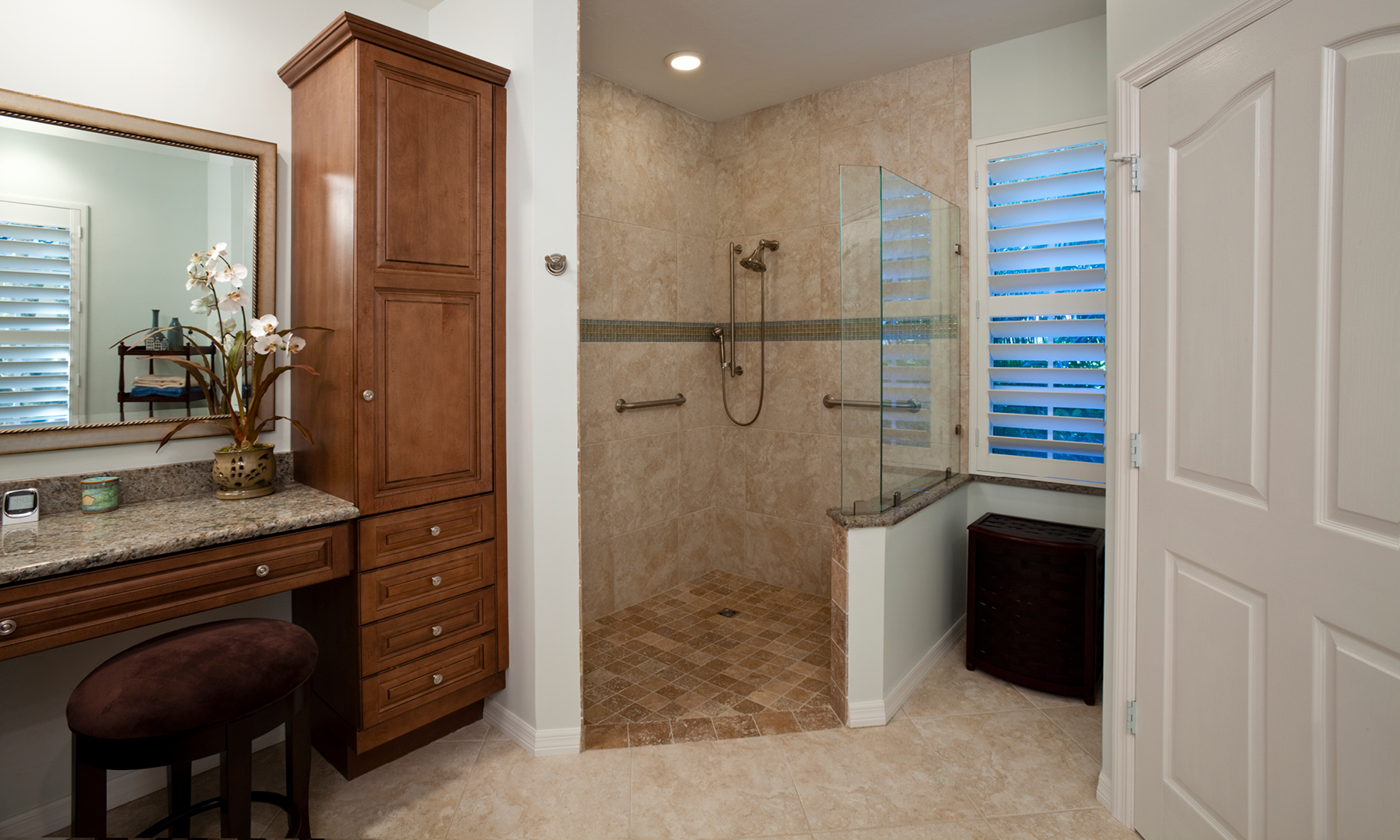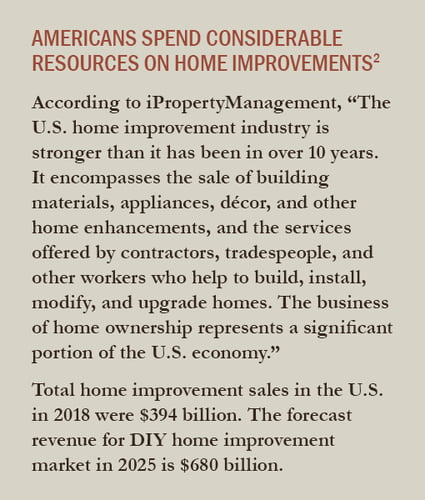4 min read
How to Adjust Your Home for Mobility and Convenience
 Cody Smith Private Banking Relationship Manager
:
Apr 7, 2022 3:07:00 PM
Cody Smith Private Banking Relationship Manager
:
Apr 7, 2022 3:07:00 PM

According to a recent study by Houzz, Baby Boomers age 55 or older make up more than half of individuals in the market for home renovations. As they look toward their housing needs for the future, many are considering remodeling changes that will enable them to age-in-place rather than downsizing to a smaller home, moving to a senior community, or entering into an assisted-living facility.
The nationwide shortage of housing and record-high home prices is also contributing to the growing trend of Baby Boomers wanting to age-in-place rather than relocate. Almost half of American homeowners are living in the first home they purchased. Of those who have lived there more than six years, 61% will choose to renovate to meet their specific needs instead of moving. 2
If you’re leaning toward that direction too, here are a few things to consider to ensure you’re getting the most value from the age-in-place renovations and remodeling upgrades you may be considering for your property.

IMPROVE APPEARANCE AND FUNCTION WITH SAFETY IN MIND
As you age and face the possibility of new health issues surfacing, your home could quickly become a challenging environment to navigate on a day-to-day basis. But there are many ways to renovate your existing property with modern, attractive updates that will help keep you safe as you grow older. Here are four home improvements you may want to consider now that will continue to be attractive, convenient additions in the future.
INSTALL AN ELEVATOR. Adding an elevator to your multi-level home is one popular solution for individuals with mobility issues. Because its design can be integrated into the architecture, the elevator can be an elegant and swift alternative to ramps or stairlifts.
According to HomeAdvisor.com, installing a residential elevator costs an average of $30,000, depending on the type you choose. For example, a pneumatic vacuum elevator can range in price from $35,000 to $60,000 while a shaftless elevator can range from $15,000 to $25,000. While adding an elevator to your home may seem like an extravagant expense, it does drive up the total value of your property. An elevator also makes your home safer and more accessible to friends and family.
REMODEL THE BATHROOM. Safer, more modern bathrooms are near the top of the list of popular renovation projects for people of all ages, but especially for aging Baby Boomers.
Some individuals are removing tubs in their main bathroom to accommodate ongoing, age-related health issues like arthritis and recovery from surgical procedures including hip and knee replacement. Bathtubs are being replaced with curbless showers, bench seats, vanities, and grab bars that can accommodate a person in a wheelchair, if necessary. Others are replacing their old standard bathtubs with safer, more convenient walk-in models with doors. These tubs feature non-slip floors, grab bars, and tub seats.
For those with disabilities, wet and soapy tiles can be hazardous and unforgiving if one slips and falls. The toilet is another area in the bathroom that can be dangerous. Handrails can be added near toilets to help with balance as users sit down and stand up.
Not only do all these features decrease the risk of falls, they also increase independence and create peace-of-mind for aging loved ones and their families. The costs for bathroom renovations are all across the board, depending on where you live and the extent of the work you want done. Check with your local architects and contractors for detailed bids on your project.
RENOVATE THE KITCHEN. Installing cabinets and countertops at 30 inches off the floor rather than the standard 34 inches can make it easier for a person in a wheelchair or scooter to prepare food. Doorways narrower than 32 inches may need to be widened for mobility devices to enter and exit. Lowering light switches and replacing hard-to-open doorknobs also are upgrades to consider.
According to HomeAdvisor.com, average kitchen remodeling costs range from $13,300 to $37,500 or more. They suggest your remodeling project shouldn’t cost less than 5%, or more than 15%, of your home’s value. Using this ratio will help you estimate the right amount to spend to get solid return on investment (ROI).
CHANGE AN EXISTING FLOOR PLAN. In a nutshell, the more you change the more expensive your renovation will be. The architectural design and necessary local approvals and building permits will cost from $1,000 to $5,000. For the project itself, depending on the scope of your changes, the cost could be up to $200,000 or more. The ROI is difficult to calculate as there are so many variables. But, on average, you can probably expect an 80% ROI if you decide to sell your home.
PAYING FOR YOUR HOME IMPROVEMENTS
Should you decide to finance your renovation project rather than pay cash, home equity lines of credit are one attractive option. We offer a home equity line with no bank fees at closing, and interest rates are at historical lows. Or, depending on the terms of an existing first mortgage, a refinance cash-out mortgage may be a solution if you can reduce your existing interest rate and/or reduce the term of an existing mortgage.
Contact Commerce Trust today for more information.
2 Source: Jaleesa Bustamante, iPropertyManagement.com, “Home Improvement Industry Statistics, Trends & Analysis [2020],” https://ipropertymanagement.com/research/home-improvement-industry-statistics ©2020.
The opinions and other information in the commentary are provided as of November 3, 2020. This summary is intended to provide general information only, and may be of value to the reader and audience.
This material is not a recommendation of any particular investment or insurance strategy, is not based on any particular financial situation or need, and is not intended to replace the advice of a qualified tax advisor or investment professional. While Commerce may provide information or express opinions from time to time, such information or opinions are subject to change, are not offered as professional tax, insurance or legal advice, and may not be relied on as such.
Data contained herein from third-party providers is obtained from what are considered reliable sources. However, its accuracy, completeness or reliability cannot be guaranteed.
Commerce Trust is a division of Commerce Bank.
If you’re leaning toward that direction too, here are a few things to consider to ensure you’re getting the most value from the age-in-place renovations and remodeling upgrades you may be considering for your property.

IMPROVE APPEARANCE AND FUNCTION WITH SAFETY IN MIND
As you age and face the possibility of new health issues surfacing, your home could quickly become a challenging environment to navigate on a day-to-day basis. But there are many ways to renovate your existing property with modern, attractive updates that will help keep you safe as you grow older. Here are four home improvements you may want to consider now that will continue to be attractive, convenient additions in the future.
INSTALL AN ELEVATOR. Adding an elevator to your multi-level home is one popular solution for individuals with mobility issues. Because its design can be integrated into the architecture, the elevator can be an elegant and swift alternative to ramps or stairlifts.
According to HomeAdvisor.com, installing a residential elevator costs an average of $30,000, depending on the type you choose. For example, a pneumatic vacuum elevator can range in price from $35,000 to $60,000 while a shaftless elevator can range from $15,000 to $25,000. While adding an elevator to your home may seem like an extravagant expense, it does drive up the total value of your property. An elevator also makes your home safer and more accessible to friends and family.
REMODEL THE BATHROOM. Safer, more modern bathrooms are near the top of the list of popular renovation projects for people of all ages, but especially for aging Baby Boomers.
Some individuals are removing tubs in their main bathroom to accommodate ongoing, age-related health issues like arthritis and recovery from surgical procedures including hip and knee replacement. Bathtubs are being replaced with curbless showers, bench seats, vanities, and grab bars that can accommodate a person in a wheelchair, if necessary. Others are replacing their old standard bathtubs with safer, more convenient walk-in models with doors. These tubs feature non-slip floors, grab bars, and tub seats.
For those with disabilities, wet and soapy tiles can be hazardous and unforgiving if one slips and falls. The toilet is another area in the bathroom that can be dangerous. Handrails can be added near toilets to help with balance as users sit down and stand up.
Not only do all these features decrease the risk of falls, they also increase independence and create peace-of-mind for aging loved ones and their families. The costs for bathroom renovations are all across the board, depending on where you live and the extent of the work you want done. Check with your local architects and contractors for detailed bids on your project.
RENOVATE THE KITCHEN. Installing cabinets and countertops at 30 inches off the floor rather than the standard 34 inches can make it easier for a person in a wheelchair or scooter to prepare food. Doorways narrower than 32 inches may need to be widened for mobility devices to enter and exit. Lowering light switches and replacing hard-to-open doorknobs also are upgrades to consider.
According to HomeAdvisor.com, average kitchen remodeling costs range from $13,300 to $37,500 or more. They suggest your remodeling project shouldn’t cost less than 5%, or more than 15%, of your home’s value. Using this ratio will help you estimate the right amount to spend to get solid return on investment (ROI).
CHANGE AN EXISTING FLOOR PLAN. In a nutshell, the more you change the more expensive your renovation will be. The architectural design and necessary local approvals and building permits will cost from $1,000 to $5,000. For the project itself, depending on the scope of your changes, the cost could be up to $200,000 or more. The ROI is difficult to calculate as there are so many variables. But, on average, you can probably expect an 80% ROI if you decide to sell your home.
PAYING FOR YOUR HOME IMPROVEMENTS
Should you decide to finance your renovation project rather than pay cash, home equity lines of credit are one attractive option. We offer a home equity line with no bank fees at closing, and interest rates are at historical lows. Or, depending on the terms of an existing first mortgage, a refinance cash-out mortgage may be a solution if you can reduce your existing interest rate and/or reduce the term of an existing mortgage.
Contact Commerce Trust today for more information.
2 Source: Jaleesa Bustamante, iPropertyManagement.com, “Home Improvement Industry Statistics, Trends & Analysis [2020],” https://ipropertymanagement.com/research/home-improvement-industry-statistics ©2020.
The opinions and other information in the commentary are provided as of November 3, 2020. This summary is intended to provide general information only, and may be of value to the reader and audience.
This material is not a recommendation of any particular investment or insurance strategy, is not based on any particular financial situation or need, and is not intended to replace the advice of a qualified tax advisor or investment professional. While Commerce may provide information or express opinions from time to time, such information or opinions are subject to change, are not offered as professional tax, insurance or legal advice, and may not be relied on as such.
Data contained herein from third-party providers is obtained from what are considered reliable sources. However, its accuracy, completeness or reliability cannot be guaranteed.
Commerce Trust is a division of Commerce Bank.
